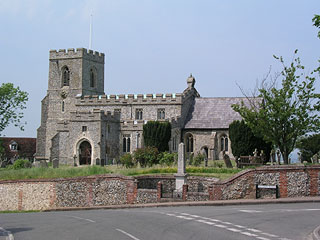Traditionally, this is an Essex parish, and it is still under the jurisdiction of the diocese of Chelmsford rather than Ely. In 1895, though, Great and Little Chishill and Heydon were transferred to Cambridgeshire. The nearby village of Chrishall, though, stayed in Essex and the Chishills were called the Chishalls until they changed the name for some reason in 1929. So, Chrishall is in Essex, and the two Chishills (formerly Chishall) were in Essex, but are now in Cambridgeshire. Got that? Good.
Whether it's Essex or Cambridgeshire, It's a lovely stretch of countryside - the hills stretch from the south-west, where they become the Chilterns, to the north-east, where they end in the rather pathetic Gog Magog hills. In my first term at university I was feeling thoroughly miserable one day and decided to go for a walk in the countryside. A look at the map indicated that there were some hills to the south-east of Cambridge, and so I caught a bus out to Babraham Park & Ride and wandered out to Wandlebury. This is an Iron Age hillfort, from the 5th century BC, and it crowns the highest part of the Gog Magog hills. Hills? I've seen bigger undulations on the Cam when the wind gets up. It was thoroughly disappointing.
The hills around the Chishills, on the other hand, are not the least bit disappointing. Here the chalk downs are quite deeply cut by river valleys. Meadows of wildflowers loom over the little roads, and small woods cling to the slopes. The character is quite different to anything else in Cambridgeshire (or anywhere in East Anglia, for that matter). Standing in the churchyard of St Swithun's looking out over the vales and fields, it was more like being in Oxfordshire or Wiltshire than anything else. The church really does have a wonderful position: perched high on a mound above the village, with the valley falling away to the north west. The mound is quite prounounced - there's a steep slope on all but the eastern edge of the churchyard - and I wondered whether this mightn't have been a pagan site once upon a time. It's certainly an old dedication.
From the outside, the church is solid and rather ship-like. The tower is late 19th century, the last one having fallen, but it fits well with the rest of the church and I wouldn't have noticed if it hadn't been pointed out by the church guide. There is a sanctus bell turret above the chancel arch, and the porch is big and square - it must at one point have contained a parvise. There's a nice stoup by the door, though it is now bereft of its bowl and a bit battered.
Within, the nave is rather grand, and reminded me of a mid-sized Suffolk church. The piers in the north nave arcade is an interesting lozenge shape, edge-on to the nave. The wall between the nave and the chancel is very solid, and pierced only by a relatively small chancel arch and a rather oversized squint. A screen would have been a bit unnecessary here. Interestingly, the chancel arch is not in line with the nave but is in line with the tower arch (which the Victorian restorers kept) - Pevsner suggests that the north arcade and aisle must have been rebuilt after the south arcade and pushed back further than the old north wall had been, which seems plausible. The effect is cheerfully lopsided.
St Swithun's was open when we visited
